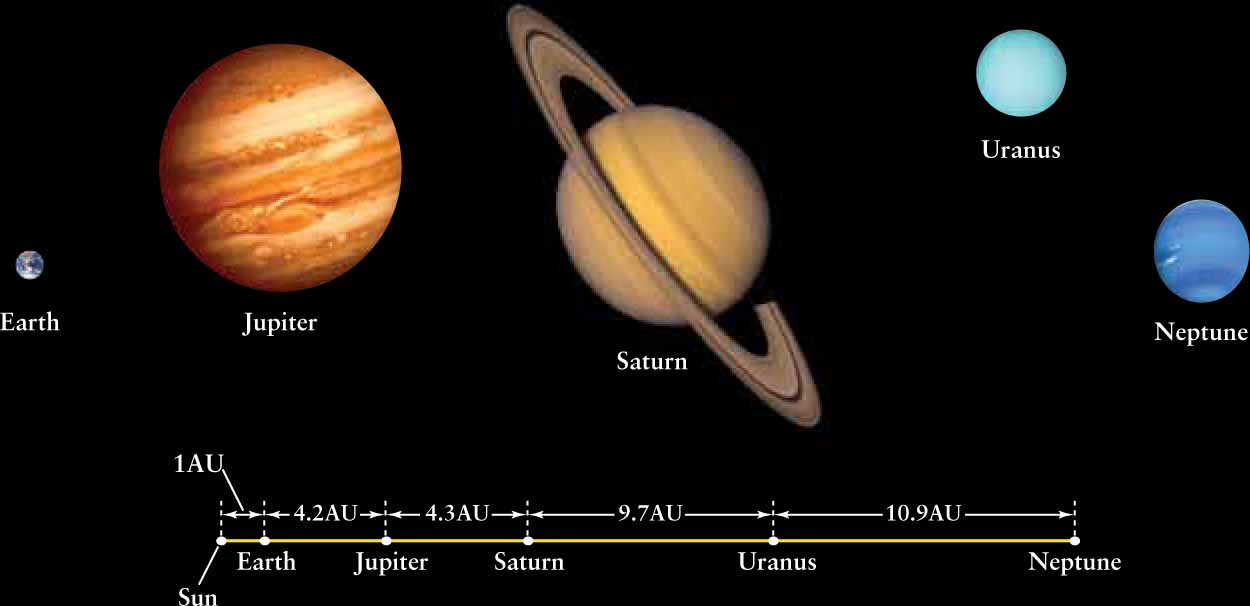14-5 The magnetic fields of both Uranus and Neptune are oriented at unusual angles
Astronomers were quite surprised by the data sent back from Voyager 2’s magnetometer as the spacecraft sped past Uranus and Neptune. These data, as well as radio emissions from charged particles in their magnetospheres, showed that the magnetic fields of both Uranus and Neptune are tilted at steep angles to their axes of rotation (Figure 14-8). Uranus’s magnetic axis, the line connecting its north and south magnetic poles, is inclined by 59° from its axis of rotation; Neptune’s magnetic axis is tilted by 47°. By contrast, the magnetic axes of Earth, Jupiter, and Saturn are all nearly aligned with their rotation axes; the angle between their magnetic and rotation axes is 12° or less. Scientists were also surprised to find that the magnetic fields of Uranus and Neptune are offset from the centers of the planets.

CAUTION!
The drawing of Earth’s magnetic field at the far left of Figure 14-8 may seem to be mislabeled, because it shows the south pole of a magnet at Earth’s north pole. But, in fact, this is correct, as you can understand by thinking about how magnets work. On a magnet that is free to swivel, like the magnetized needle in a compass, the “north pole” is called that because it tends to point north on Earth. Likewise, a compass needle’s south pole points toward the south on Earth. Furthermore, opposite magnetic poles attract. If you take two magnets and put them next to each other, they try to align themselves so that one magnet’s north pole is next to the other magnet’s south pole. Now, if you think of a compass needle as one magnet and the entire Earth as the other magnet, it makes sense that the compass needle’s north pole is being drawn toward a magnetic south pole—which happens to be located near Earth’s geographic north pole. Earth’s magnetic pole nearest its geographic North Pole is called the “magnetic north pole.” Note that the magnets drawn inside Jupiter, Saturn, and Neptune are oriented opposite to Earth’s. On any of these planets, the north pole of a compass needle would point south, not north!
Explaining Misaligned Magnetism
Unlike any other planets, Uranus and Neptune have magnetic fields caused by ionized ammonia
Why are the magnetic axes and axes of rotation of Uranus and Neptune so badly misaligned? And why are the magnetic fields offset from the centers of the planets? One possibility is that their magnetic fields might be undergoing a reversal; geological data show that Earth’s magnetic field has switched north to south and back again many times in the past. Another possibility is that the misalignments resulted from catastrophic collisions with planet-sized bodies. As we discussed in Section 14-2, the tilt of Uranus’s rotation axis and its system of moons suggest that such collisions occurred long ago. As we will see in Section 14-7, Neptune may have gravitationally captured its largest moon, Triton, but no one knows if that incident was responsible for offsetting Neptune’s magnetic axis.
Because neither Uranus nor Neptune is massive enough to compress hydrogen to a metallic state, their magnetic fields cannot be generated in the same way as those of Jupiter and Saturn. Instead, under the high pressures found in the watery mantles of Uranus and Neptune, dissolved molecules such as ammonia lose one or more electrons and become electrically charged (that is, they become ionized; see Section 5-8). Water is a good conductor of electricity when it has such electrically charged molecules dissolved in it, and electric currents in this fluid are probably the source of the magnetic fields of Uranus and Neptune.
The Cosmic Connections figure summarizes the key properties of Uranus and Neptune and how they compare with those of Jupiter and Saturn.
COSMIC CONNECTIONS
The Outer Planets: A Comparison
Uranus and Neptune are not simply smaller versions of Jupiter and Saturn. This table summarizes the key differences among the four Jovian planets.
| Interior | Surface | Rings | Atmosphere | Magnetic Field | |
| Jupiter | Terrestrial core, thick liquid metallic hydrogen layer, molecular hydrogen | No solid surface, atmosphere gradually thickens to liquid state, belt and zone structure, hurricanelike features | Yes | Primarily H, He | 19,000 × Earth’s total field; at its cloud layer, 14 × stronger than Earth’s surface field |
| Saturn | Similar to Jupiter, with bigger terrestrial core and less metallic hydrogen | No solid surface, less distinct belt and zone structure than Jupiter | Yes | Primarily H, He | 570 × Earth’s total field; at its cloud layer, ⅔ × Earth’s surface field |
| Uranus | Terrestrial core, liquid water shell, liquid hydrogen and helium mantle | No solid surface, weak belt and zone system, hurricanelike features, color from methane absorption of red, orange, yellow | Yes | Primarily H, He, some CH4 | 50 × Earth’s total field, at its cloud layer, 0.7 × Earth’s surface field |
| Neptune | Similar to Uranus | Similar to Uranus | Yes | Primarily H, He, some CH4 | 35 × Earth’s total field, at its cloud layer, 0.4 × Earth’s surface field |
For detailed comparisons between planets, see Appendices 1 and 2.
*To see the orientations of these magnetic fields relative to the rotation axes of the planets, see Figure 14-8.

CONCEPT CHECK 14-5
In order for a magnetic dynamo to create a global magnetic field around Uranus and Neptune, these planets must have an electrically conducting fluid. What is that conducting fluid thought to be?
Ammonia dissolved in water under high pressure loses electrons, which become free to move, and this makes the fluid electrically conductive.